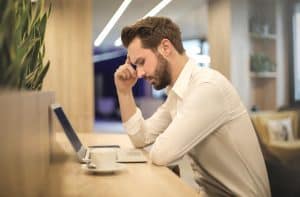Online learning is on the rise. But is this helping or harming education?
Gaining knowledge through a screen is a runaway trend. You hear about its benefits everywhere.
DIY programs are the new bandwagon that lots of eager learners jump on. Even companies and big university names seem bent on tapping into its potential.
Without question, online education is thriving, at least in terms of popularity.
And it’s easy to see why.
There are 3-key benefits that e-learning brings to the table:
- It’s cheap.
- It’s convenient.
- It’s accessible.
Studying online doesn’t include the costs of housing, transportation, and amenities that come with traditional education. In addition, tuition fees tend to be lower for e-learning. Online courses can also be accessed anywhere, at any time – all you need is a modest internet connection.
These elements combined make online education not only far more accessible to a wider range of people across the globe but also much more appealing.
You can pay less to learn at your own pace from the comfort of your home.
Sounds pretty cool, right?
The issue comes when the raw, nitty-gritty reality of online education doesn’t live up to the hype that’s surrounding it.
In other words, online education and DIY programs look great on paper but lack substance in practice.
If we were to take a sobering, unbiased look at the type of learning experience that an online medium provides in today’s highly digitized era, how effective would we find it when it comes to improving learning outcomes, performance, and knowledge retention?
What nobody tells you about online education
In theory, e-learning is amazing. It promises fast access to diverse and affordable information.
What it does not promise, however, is a higher quality of education, depth of knowledge or strong interpersonal relationships that have been the cornerstone of learning for centuries and have played a major part in driving innovation and progress.
What very few people know about online education (and what I like to call its dirty little secret) is this: students are dropping out of online learning programs at record rates.
What’s the evidence?

Learners enrolled in online programs often report feeling disengaged or easily distracted, as well as finding it difficult to apply the information they learn in their day-to-day routine at work or in school and university.
In fact, between 40% and 80% of online students drop out.
Moreover, the incompletion rate of DIY academic learning is very high, in some cases up to 90%, with an average of 15% completion rate for MOOCs (Massive Open Online Courses).
Here are more research figures on e-learning (that you don’t often hear about online or in the media) which might surprise you:
- Only 5% of community college leaders said that students did better in online programs, and nearly 60% of school leaders in charge of teaching online courses said that students performed worse in online courses than in on-site classes.
- The average cost per credit in-state for an online Bachelor’s program was $277 compared to $243 per credit at traditional schools, making online alternatives more expensive than conventional learning.
- 74% of online education providers charged the same tuition for online programs and on-campus programs, while 23% of them charged more for their online programs than any others, including on-site ones.
These numbers should be concerning and worth investigating for any teacher, mentor, or coach who is interested in providing the best for their students, as well as any learner who’s eager to expand their knowledge or get certified in their field of study.
Put simply, e-learners are often on the brink of quitting the online programs they’ve signed up for.
This is often due to the poor learning experience that these programs often provide but also due to their inefficiency when it comes to helping students achieve their professional or academic goals.
There’s no doubt about it: online education is a comfortable alternative. But since when does comfort equal achievement, quality, and growth?
If your aim is to create a well-rounded, relevant, and comprehensive learning experience that improves outcomes for students and employees alike, then a more effective approach is in order.
You’re looking for a way of combining the high-value aspects of online education (accessibility, lower cost, convenience) with group-based, interactive methods that are proven to boost performance, engagement, and knowledge retention.
Put simply, to get the highest performance, your aim should be to get the best of both worlds.
How to make the most of online education

So far we’ve taken a look at the 3 key benefits of online education: cost, convenience, and accessibility.
It’s clear that online education has come a long way in a fairly short amount of time. But its rapid growth has made room for gaps that, if left unchecked, dramatically lower the quality of the learning experience it can provide.
To keep the process evolving, you need to develop new and improved strategies of delivering online education. These methods need to be diverse, interactive, and able to drive a track record of success which ensures that e-learning can be a sustainable initiative long-term.
Here are some of the primary methods we recommend using (that you can also find in our programs):
- Online education programs featuring real-time, mentored small groups
- Interactive strategies for problem- and project-based learning
- Gamification and role-playing
- Storytelling and the use of fiction
- Social and Active learning
- Case-based learning
- Microlearning
Why this works
Cost, convenience, and accessibility are important in education. But so are interpersonal relationships, depth of learning and quality of experience. A combined approach guarantees the benefits of both models.
Here is why group-based, interactive online education provides the best of both worlds and succeeds in significantly improving learning outcomes and retention:
1. Learning is about the relationships that are formed with your teacher and your peers.
If you are in an online learning program with simple objective assessments and only asynchronous communications (discussion threads that are not “real-time”), the quality of the communication degrades and learning is superficial.
Asynchronous forums are unsatisfactory owing to communication decay: the longer the time between responses, the more likely you are to forget what you were talking about. Online asynchronous discussions (as with social media discussions) are unsatisfying in that they rarely conclude optimally, deliver real insights, and challenge our thinking.
Moreover, the motivation that drives most students is simply passing the quiz in order to get a certification. This is not a solid foundation for in-depth study and learning efficacy.
This is why, at Practical Academics, we use synchronous (real-time) mentor-led group meetings, which allow these complex communications and thus more meaningful and satisfying discussions. We still get the benefits of DIY as our content is online but we also add the benefits that relationships bring to the learning experience.
Put simply, DIY models offer superficial knowledge and an absence of real, thought-provoking communication whereas newer interactive models build a strong foundation for mastery.
2. Depth of learning is the key to retention.
Your learning is deeper and you retain it better when you practice your new knowledge in projects, analyze case studies, and practice with role plays.
This is reflected in a standard education theory called “Bloom’s taxonomy of cognitive engagement”. Every educator knows this, and education programs that promote DIY learning are really just after your money. Why?
Because DIY models are mostly oriented towards knowledge transfer and skill-building. But they lack any perspective development. They are wasting your time and offering a cheap product that will not deliver the results you’re after. And the reputations of the great schools that use this model will suffer in time.
By using interactive models instead, we can move towards subjective learning and perspective development. Through applications and group dynamics, participants develop more nuanced knowledge, insight and wisdom.
In addition, participants also develop “soft skills” and increased empowerment which is necessary to rise in their careers, develop quality personal relationships, and participate in civic dialogue more effectively.
3. Quality of experience can be transformative.

Taking a DIY online class is like reading a really good multimedia book by yourself.
But learning is enhanced in the relationship with your mentor and your peers.
A great novel can hold your attention, enrich, and transform your life. But most folks don’t read non-fiction “for fun”. Most non-fiction is read for a purpose. You go in, get what you need, and move on to your task.
Most non-fiction serves another purpose. If your purpose is to better yourself, change your lifestyle behaviors, to sort through a career choice, to advance your career, or to become a better citizen, you need to learn foundational knowledge, then move forward to apply that knowledge in practice.
By working in groups led by a mentor, you practice your knowledge, test out your new ideas with peers, and hold each other accountable for commitments, attendance, and completion. Over time, participants develop trusting and caring relationships with their classmates. It is these experiences shared within bonded relationships that result in a quality learning experience.
Interested in learning more about interactive learning strategies that empower students and drive results?
Take a look at some of our workshops and help us transform online education step by step by working our way up with smarter design decisions that focus on quality over price and adding value along with convenience.


Recent Comments